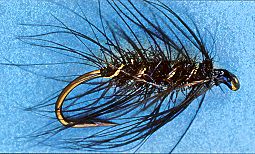Great Canadian Flies
The Haig-Brown Caterpillars

By Arthur James Lingren

During the writing of The Western Angler, Haig-Brown
jotted down his thoughts of things that he wanted to include in his
book. In his notes on stream cutthroat patterns, he gave some rules
for tying:
1. Impression rather than imitation.
2. Seal's fur body or silver body.
3. Palmer-wise hackle lightly veiling all except sil[ver] body.
4. Imitation: amusement rather than anything else.
Simple flies such as Brown & black caterpillar is as good as any.
Can be tied simply or with complication - Simple just as good.
"Secrets" all nonsense.
In a margin note he says that his Black Caterpillar "on No.
6-8 hook, ragged black or metallic green feather wound over [is]
an A-1 ant imitation." During his research he learned that places
like Harkley & Haywood in Vancouver considered the make-up of many
local fly patterns to be trade secrets and wouldn't give him
pattern listings. He pondered if he should release the secret
ingredient for his Black Caterpillar. However, in his cutthroat
notes he put an asterisk beside his Black Caterpillar in two
different locations and noted at the bottom on his notebook page
"to hell with 'secrets'" and that the asterisk referred to
"secret materials."
Although he listed hook sizes in 4 to 8 in The Western
Anglers (1939) for his Black and Brown Caterpillars, he
says that they are "both good, No's 2/0 - 10" and that the Brown
Caterpillar was "also good [for] summer steelhead." I can
attest that Thompson River rainbows and whitefish also find
the Brown Caterpillar appealing, Vancouver Island rainbows also
like the Black Caterpillar.
In 1994, Van Egan and I made a spring trip up into Haig-Brown
country and fished the Nimpkish River system. We encountered
poor fishing conditions and fish were hard to find. I decided
that I would search the water with the only Black Caterpillar I
had in my fly box. Five out of the ten rainbows I managed to
find, with 16 inches the largest, came to the Black Caterpillar.
And of course when you have a single sample of a fly that is
working well something usually happens to it and eventually
the body hackle was severed by a fish's teeth.
Why the Black Caterpillar was so effective that day, I can't
answer; although, under tying fishing conditions, I often put on
a black fly and get results. However, I believe like Haig-Brown
that "there are no 'sure-killer' flies" and that "there are plenty
of adequate flies and that's all a decent fisherman needs."
Haig-Brown, after he noted the dressings for the Black and Brown
caterpillars, recommended "other caterpillars [of] different
seal's fur [with] matching hackle" and says that "Orange good,
Fiery brown good, etc. etc." [These caterpillars were tied in
Black, Brown, Orange and Fiery Brown.]
Details
Hook: Number 6 or 8.
Body: Black seal's fur.
Rib: Fine, oval gold tinsel.
Hackle: Black [long and soft].
Originator: Roderick Haig-Brown.
Intended Use: Wet fly for cutthroat and rainbow trout.
Location: Campbell River, B.C. Canada.
~ Arthur James Lingren
Credits: From Fly Patterns of British Columbia
by Arthur James Lingren. We thank
Frank Amato Publications, Inc. for use permission!
Our Man In Canada Archives
|

